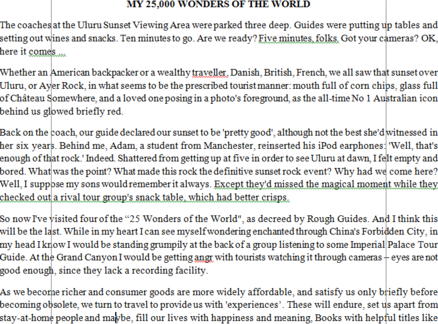Read the following passage and mark the letter A, B, C or D to indicate the correct answer to each of the questions from 36 to 42.
Most forms of property are concrete and tangible, such as houses, cars, furniture or anything else that is included in one’s possessions. Other forms of property can be intangible and copyright deals with intangible forms of property. Copyright is a legal protection extended to authors of creative works, for example, books, magazine articles, maps, films, plays, television shows, software, paintings, photographs, music, choreography in dance and all other forms of intellectual or artistic property.
Although the purpose of artistic property is usually public use and enjoyment, copyright establishes the ownership of the creator. When a person buys a copyrighted magazine, it belongs to this individual as a tangible object. However, the authors of the magazine articles own the research and the writing that went into creating the articles. The right to make and sell or give away copies of books or articles belongs to the authors, publishers, or other individuals or organizations that hold the copyright. To copy an entire book or a part of it, permission must be received from the copyright owner, who will most likely expect to be paid.
Copyright law distinguishes between different types of intellectual property. Music may be played by anyone after it is published. However, if it is performed for profit, the performers need to pay a fee, called a royalty. A similar principle applies to performances of songs and plays. On the other hand, names, ideas, and book titles are accepted. Ideas do not become copyrighted property until they are published in a book, a painting or a musical work. Almost all artistic work created before the 20th century is not copyrighted because it was created before the copyright law was passed.
The two common ways of infringing upon the copyright are plagiarism and piracy. Plagiarizing the work of another person means passing it off as one’s own. The word plagiarism is derived from the Latin plagiarus, which means “abductor”. Piracy may be an act of one person, but, in many cases, it is a joint effort of several people who reproduce copyrighted material and sell it for profit without paying royalties to the creator. Technological innovations have made piracy easy and anyone can duplicate a motion picture on videotape, a computer program, or a book. Video cassette recorders can be used by practically anyone to copy movies and television programs, and copying software has become almost 'as easy as copying a book. Large companies zealously monitor their copyrights for slogans, advertisements, and brand names, protected by a trademark.
Question 38: The word “principle” in paragraph 3 is closest in meaning to ______.
A. crucial point
B. cardinal role
C. fundamental rule
D. formidable force






Đáp án C
Dịch nghĩa. Từ “principle” - quy tắc - ở đoạn 3 gần nghĩa nhất với
A. điểm mấu chốt B. vai trò chính
C. quy định cơ bản D. bắt buộc nghiêm khắc